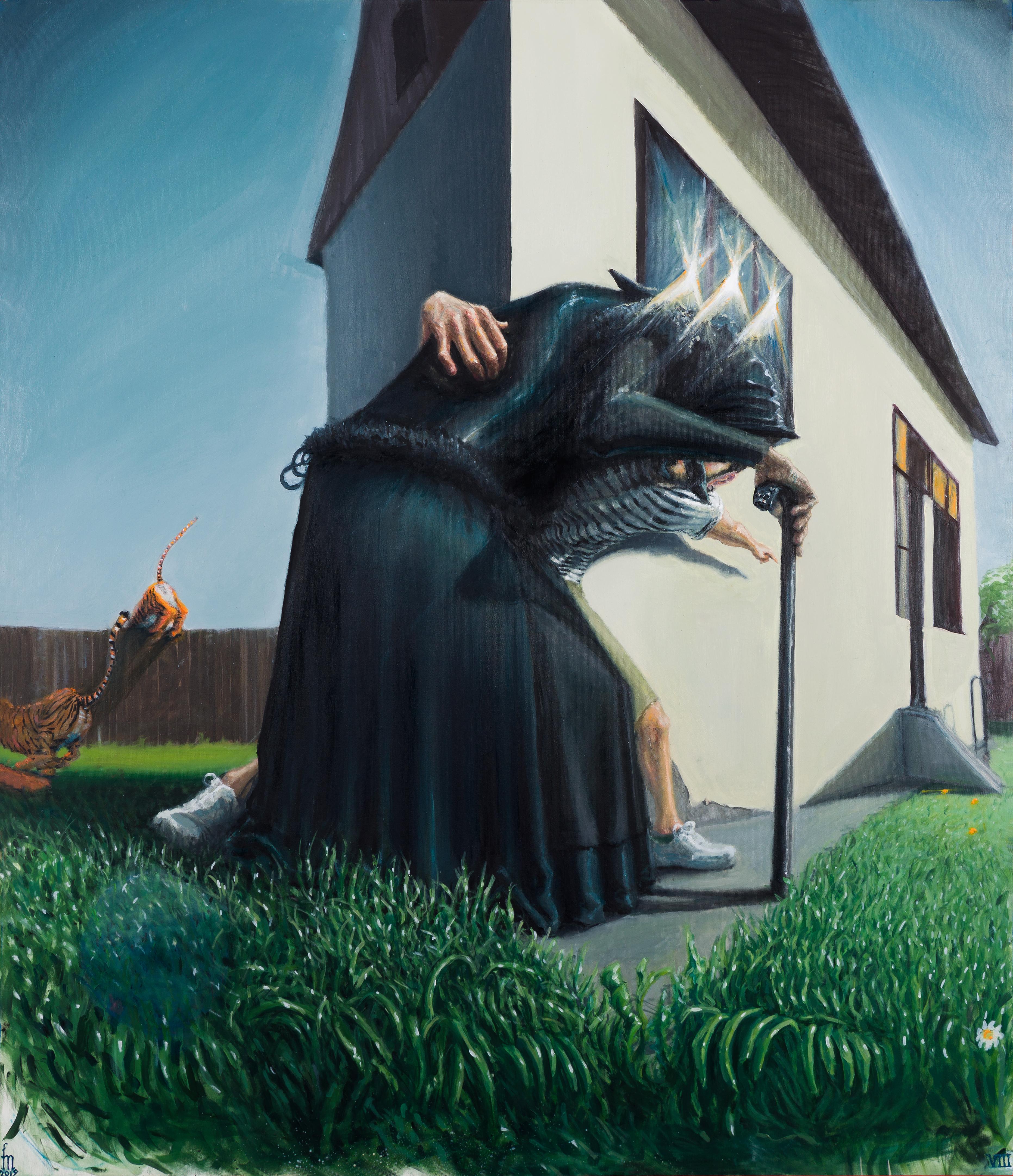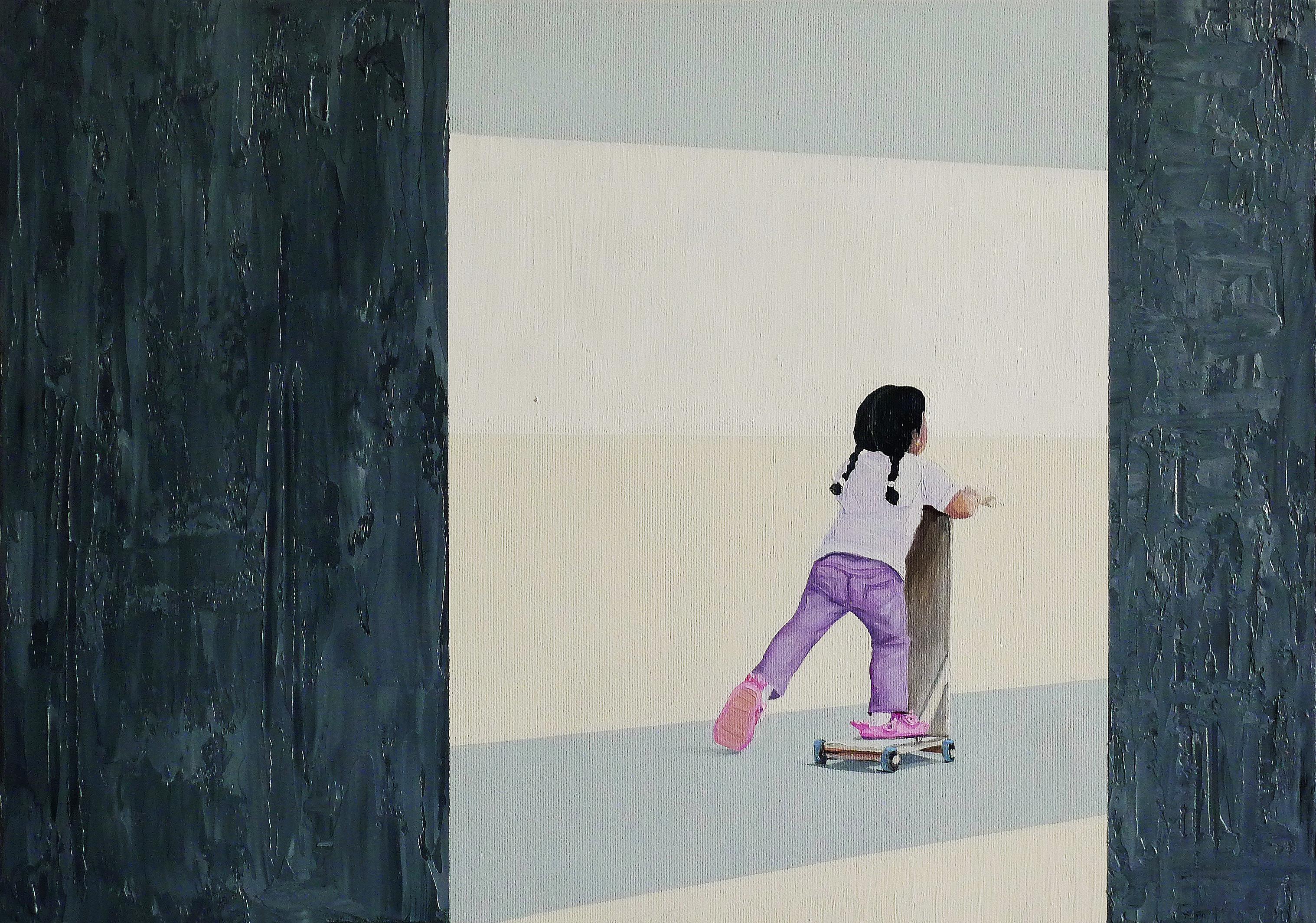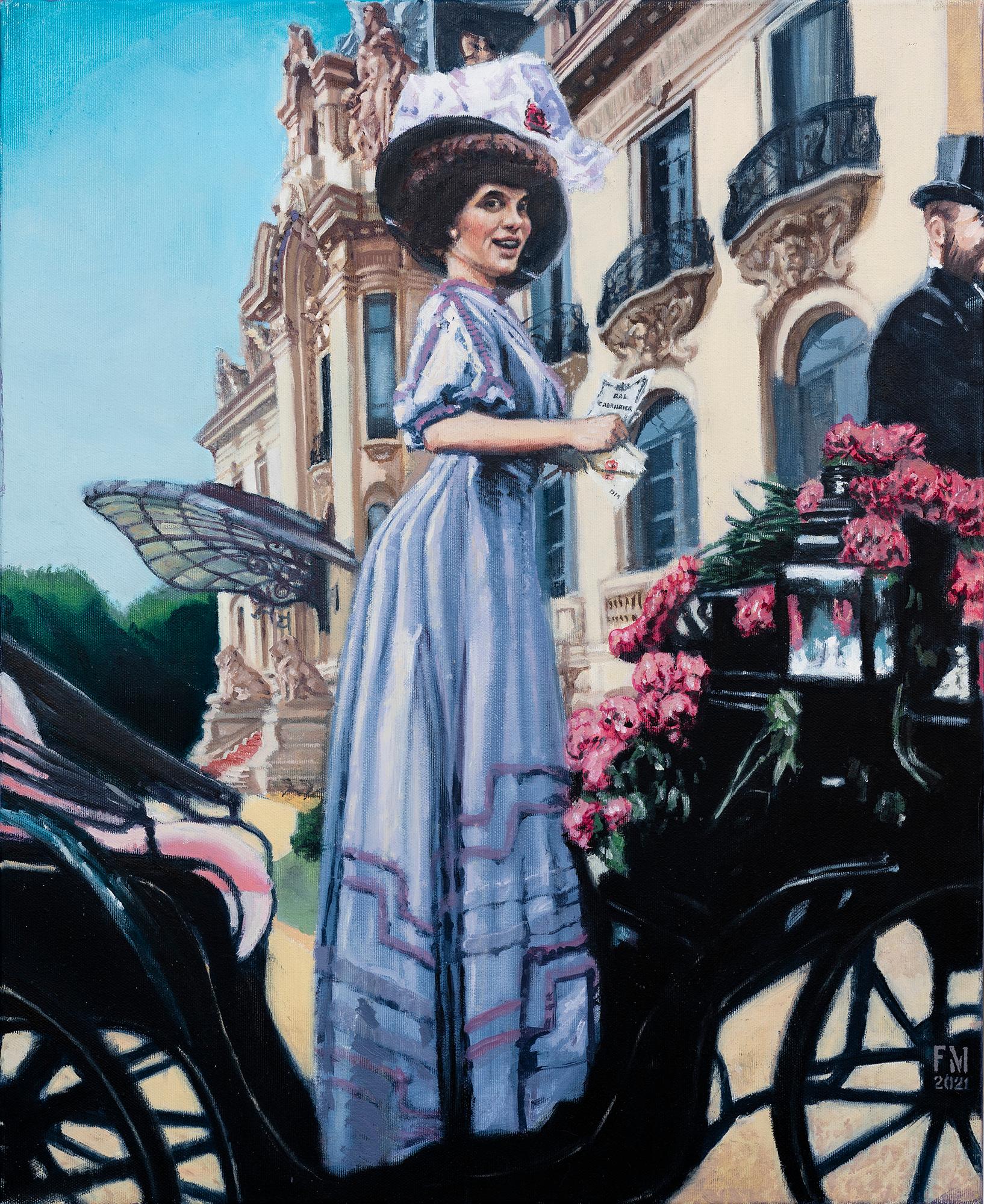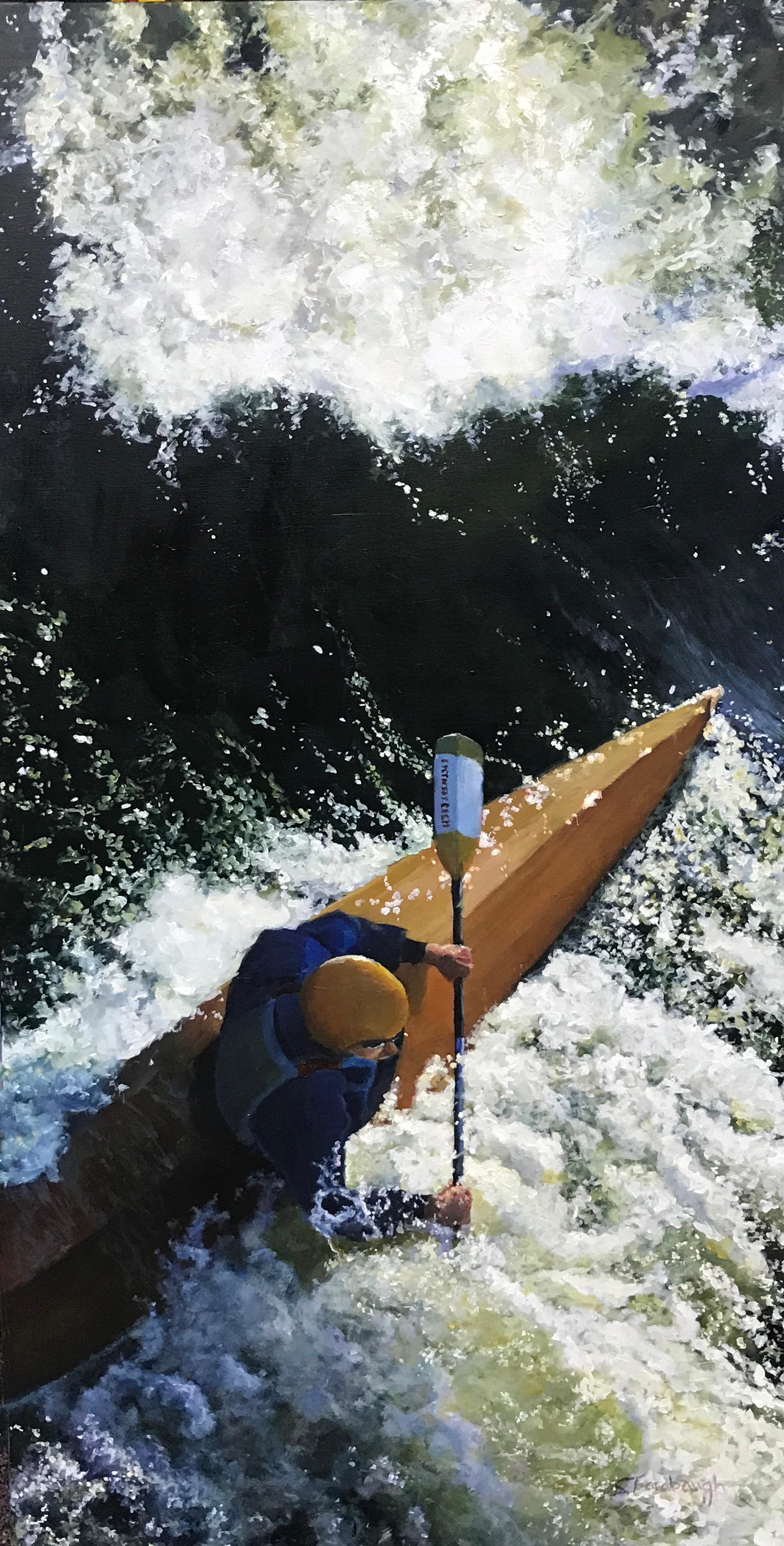Items Similar to Arie Azene Israeli Photo Realist Oil Painting Manhattan New York Street Scene
Want more images or videos?
Request additional images or videos from the seller
1 of 13
Arie AzeneArie Azene Israeli Photo Realist Oil Painting Manhattan New York Street Scenec.1990's
c.1990's
About the Item
Arie Azene, Israeli painter, born in Germany, 1934
Arie (Eisman) Azene was born in Hamburg, Germany. He immigrated to the Land of Israel with his parents soon after birth. In 1958, after studying art in Paris, he settled on Kibbutz Tzova in the Judean Hills, where he lived for 28 years. He spent 1968-1970 in France, England and Germany. In 1984, he moved to Jerusalem.
Stylistically, Azene was influenced by the New Horizons group to which he was exposed during his studies at the Avni Institute in Tel Aviv. Other influences were Joseph Zaritsky, Avigdor Stematsky and Yehezkel Streichman.
Azene works in oil paint, pencil and aquarelle. His early work was abstract, but over the years, it has become more figurative and realistic. His colour palette is often based on two complementary hues, with a predominance of various combinations of gray.
Education
1948-51 Avni Institute, Tel Aviv
1951-52 Bezalel Academy of Arts and Design, Jerusalem
1957-58 Academie de la Grande Chaumiere, Paris, France, Advanced Studies
Select Exhibitions
Autumn Exhibition Autumn Exhibition Yad Lebanim Museum, Petach Tikva 1974
Artists: Shimon Avni, Mordechai Avniel, Azene, Arie, Eli Ilan, Michael Argov, Naftali Bezem, Nachum Gutman, Shraga Weil, Boaz Vaadia, Shmuel Katz, Ruth Schloss.
Zaritsky Artists House, Tel Aviv 1976
Artists: Yitzhak Danziger, Menashe Kadishman, Osvaldo Romberg, Michal Wolman, Raffi Lavie
The Kadishman Connection Israel Museum, Jerusalem 1979
Artists: Larry Abramson, Jacob El Hanani, Ovadia Alkara, Yosl Bergner, Marcel Janco, Lea Nikel, George Chemeche, Igael Tumarkin.
Israeli Prints from the Burston Graphic Center Israel Museum, Jerusalem 1981
Avigdor Arikha, Jean David, Ivan Schwebel, Louise Schatz, Moshe Kupferman.
Photorealism evolved from Pop Art as a counter to Abstract Expressionism. Photorealists use a photograph or several photo works to gather the information to create their paintings and it can be argued that the use of a camera and photographs is an acceptance of Modernism.
The word Photorealism was coined by Louis K. Meisel in 1969 and appeared in print for the first time in 1970 in a Whitney Museum catalogue for the show "Twenty-two Realists." It is also sometimes labeled as Super-Realism, New Realism, Sharp Focus Realism, or Hyper-Realism.
The first generation of American Photorealists includes the painters Richard Estes, Ralph Goings, Chuck Close, Charles Bell, Audrey Flack, Don Eddy, Robert Bechtle, Ron Kleemann, Richard McLean, John Salt, Ben Schonzeit, and Tom Blackwell.
Solo Exhibitions
1956 Tel-Aviv Museum: Israeli Artists
1962 Arie Azene - Solo exhibition, The Gallery 220, Tel-Aviv
1963 Biennale, Paris
1965 Tel-Aviv Museum: Young Artists
1967 Charlottenburg, Copenhagen
1972 Drawings, Mabat Contemporary Art Gallery, Tel Aviv New Works 1972, Engel Gallery, Shlomzion Hamalka.
1975 Paintings and Drawings 1974-75, Tel Aviv Museum of Art, Helena Rubinstein Pavilion
1977 Loeb Gallery, Bern Switzerland
1978 Colour Drawings: ''Family Album Pages'', Printer's Art Gallery, 23 rambam st. Rehavia, Jerusalem
1981 Tel-Aviv Museum: New Works ''Jerusalem'' - Watercolours, Arta Gallery, Jerusalem
1983 Nelly Aman Fine Art, Tel Aviv
1990 ''Mamilla 1989'' works on paper, Foyer, Jerusalem Theatre
1993 Arie Azene - Solo Exhibition, Elbaz Art Gallery, New York
1994 Perry Art Gallery, New York
1996 Arie Azene - Recent Works, Mayanot Gallery, Jerusalem
1997 ''Tel-Aviv'', Neve Tzedek Gallery, Tel Aviv
2003 Adenauer Center, Jerusalem
2005 Art-Time Gallery, Jerusalem. The Wardrobe, Morel Derfler Gallery, Musrara - The Naggar School of Photography, Media and New Music, Jerusalem
2006 UJC Los Angeles
2007 "Tears, Sections, Backgrounds'', Jerusalem Theatre Art Gallery
2009 "Skyline” & “Coastline”, Jerusalem Theatre Art Gallery
2010 David Yellin College Art Gallery
2014 Quartets, Chamber paintings, Jerusalem Theatre, Jerusalem
2018 Reflection: Aesthetics of Coexistence, Jerusalem Theatre, Jerusalem
Group Exhibitions
2017 Off the Record: Works from the Nava and Ronnie Dissentshik Collection, Israel Museum, Jerusalem
2015 Mus(e)ic Group Exhibition, Jerusalem Theatre, Jerusalem
2014 Lyrical? - Not Necessarily: Israeli Abstract Art in the Dubi Shiloah Collection, Open University Gallery Campus
2001 Windows, Art Center Morasha, Jerusalem
1998 Seven Works, Beck Science Center, Jerusalem
Israel - Entre Reve et Realite, Musée Juif de Belgique, Brussels
Israeli Art - 50 years of the State of Israel, Contemporary Jewish Museum, San Francisco
1997 All this Jeans, Chelouche Gallery for Contemporary Art, Tel Aviv
1996 ''We Prefer Jerusalem Above Our Chief Joy'', Yad Labanim Museum, Petach Tikva
1994 Longing... Avraham Ofek, Taamon, Coffee - Gallery, Jerusalem
1990 Israel Art Month, Jerusalem Theatre, Jerusalem
1988 Still Life, Traveling Exhibition, Israel
1981 Israeli Prints from the Burston Graphic Center, Israel Museum, Jerusalem
The Woman Image in Israeli Art, Traveling Exhibition, Israel
1979 The Kadishman Connection, , Israel Museum, Jerusalem
1977 One Hundred Years - One Hundred Plus Artists, Yad Labanim Museum, Petach Tikva
1976 Duo Exhibition, The Little Gallery 2, Jerusalem
Group Exhibition, Zaritsky Artists House, Tel Aviv
1975 Summer Exhibition, Yad Labanim Museum, Petach Tikva
1974 Autumn Exhibition, Yad Labanim Museum, Petach Tikva
1971 Abstract Artists, Tel Aviv Artists' Association Multi-ism 2, Haifa Museum of Modern Art
1968 Autumn Exhibition, Israeli Artists, Tel Aviv Museum of Art, Helena Rubinstein Pavilion
1967 Oil Paintings Exhibition, United Kibbutz Movement in cooperation with LIM Gallery
1966 The Smallest Works of a 10+ Group Artists and Others, Gordon Gallery, Tel Aviv
1965 Group exhibition, Rina Gallery, New York, USA
1963 New Horizons, Mishkan Museum of Art, Kibbutz Ein Harod
1959 New Horizons, Tel Aviv Museum of Art, Helena Rubinstein Pavilion
- Creator:Arie Azene (1934, German)
- Creation Year:c.1990's
- Dimensions:Height: 31 in (78.74 cm)Width: 41 in (104.14 cm)
- Medium:
- Movement & Style:
- Period:
- Condition:
- Gallery Location:Surfside, FL
- Reference Number:1stDibs: LU3828599392
About the Seller
4.9
Platinum Seller
These expertly vetted sellers are 1stDibs' most experienced sellers and are rated highest by our customers.
Established in 1995
1stDibs seller since 2014
1,565 sales on 1stDibs
Typical response time: 1 hour
- ShippingRetrieving quote...Ships From: Surfside, FL
- Return PolicyA return for this item may be initiated within 3 days of delivery.
More From This SellerView All
- 1980s Vintage American Street Scene Painting, Landscape with Taxi CabsBy Val LewtonLocated in Surfside, FLVal Edwin Lewton (May 23, 1937 – April 24, 2015) was a painter and museum exhibition designer. As an artist, he created Realist acrylic paintings and watercolors of urban and suburban scenes, predominantly in the Washington, D.C., area, where he lived and exhibited. Val Lewton was born May 23, 1937, in Santa Monica, California. His father, also named Val Lewton, produced a string of successful and influential B movies for RKO Pictures, including Cat People (1942) and I Walked with a Zombie (1943). His mother, Ruth Knapp, was a painter and teacher of autistic children. He graduated in 1959 from Whitman College in Walla Walla, Washington, and earned a master's degree in fine arts from Claremont University in 1962. After moving to Washington, D.C., he served on the staff of the Smithsonian American Art Museum for 32 years, simultaneously maintaining a career as a painter in his own right. Lewton died in 2015s oon afterwards, exhibitions of his paintings were planned for the Katzen Arts Center (June 17 – August 13, 2017) and Addison/Ripley Fine Art (June 3 – July 8, 2017). Chiefly known for his landscapes, Lewton generally depicted cities and suburbs with a detached, impersonal sensibility. Writing about his watercolors in Arts magazine in 1980, Harry Rand observed, “Either by implication or statement, personalities are absent from Lewton’s work; there is hardly a sense of the lives that move through those spaces he describes.” The critic compared the artist to Fairfield Porter, Edward Hopper, and Charles Sheeler. Lewton painted from a young age. On a family trip to the Museum of Modern Art in New York City, he discovered the work of Henri Matisse, an encounter that permanently influenced his artistic vision. In the early 1960s, Lewton lived in southern California and taught art classes at the University of California Riverside. During this period, he was inspired by the paintings of Roger Kuntz...Category
1980s Photorealist Landscape Paintings
MaterialsAcrylic, Archival Paper
- Naive London Street Scene Folk Art Oil Painting Big Ben, Parliament, Union JackBy Andrew MurrayLocated in Surfside, FLBig Ben, House of Parliament with Union Jack flag, Thames River, boats, barges, airplane and double decker red bus. Classic London street scene. 24 inches by 11 inches in a frame 24.5 inches by 11.5 inches. ANDREW MURRAY became known and loved as an imaginative Naive painter who captured the character of cities (especially Cape Town and London) with humorous and affectionate insight. An English counterpart to Michel Delacroix of Paris and Charles Fazzino of New York He was born in north China, the son of a missionary. As a child of five he had his first lesson in painting from the son of another, the 10-year- old Mervyn Peake...Category
20th Century Folk Art Figurative Paintings
MaterialsCanvas, Oil
- King David, Jerusalem (after Marc Chagall) Oil Painting Israeli Judaica ArtBy Zammy SteynovitzLocated in Surfside, FLFramed 41.5 x 29.5 image 35.5 x 23.5 This large painting depicts a man and woman, Adam and Eve, interlocked and embracing one another. The woman holds an enticing apple as they are thrusted from the Garden of Eden. This is an original painting. Zamy Steynovitz was born in Liegnitz Poland, in 1951. He immigrated to Israel in 1957. The aspiration to be a painter stems from his childhood and before leaving Poland, he won the first prize in an art competition for children. Zamy was formally educated at the Art School in Tel-Aviv and at the Royal Academy of London. Upon completing his studies, Zamy earnestly pursued his career and establish his place in the art world by displaying his work in one man exhibits and arts fairs around the world. His art displays chromatic and thematic richness and his choice of subjects has been strongly influenced by Jewish tradition, his Eastern European Jewish heritage and folklore. Zamy’s popular themes include Paris cafes, still-life, flowers, circuses and landscapes. Circus with acrobats and Harlequin. In the early stages of his career, he was partial to rich pastels and light brush strokes. In the early 1980s, Zamy visited South America, where the new surroundings enhanced his work with local brightness and color. His art gained chromatic power and his palette became richer in tones as the textures became thicker and the background darker and more colorful. These changes coupled with his thematic persistence allowed him to develop into a sensitive and mature artist. Zamy expresses a universal humanistic vision in his creations: man’s connection to his heritage and physical surroundings, two imperative aspects of our lives that should be heralded during these estranged technological times. As a result of his devotion to world peace, Zamy is known in the circles of the Nobel Institute for Peace in Norway. He is acquainted with many Nobel Prize winners including Anwar Sadat, Menachem Begin, the Dalai Lama, Itzhak Rabin, Shimon Peres, Elie Wiesel, Desmond Tutu and Oscar Arias, the ex-President of Costa Rica, along with many other politicians and artists. Zamy tragically passed away in September 2000. Exhibitions One Man Show 1970 - Museum - Ramat - Gan 1973 - Brussels - Gallery L'Angle Aigu 1974 - London - International Gallery 1974 - Paris - Grand Palais Gallery 1975 - Milan - Brera Gallery 1976 - N.Y. Valentino Gallery - N.Y. Hilton 1977 - N.Y. Valentino Gallery - N.Y. Hilton 1978 - Basel - Actual Gallery 1978 - Geneve - Bohren Gallery 1978 - Oslo - Nobel Peace Prize Exhibit 1979 - London - Hamilton Gallery 1979 - N.Y. - Art Israel Kalt - Waldinger Gallery 1979 - N.Y. - Canty Art Gallery 1979 - Amsterdam - Schipper Gallery 1979 - Washington - International Art Fair 1980 - Cleveland -Jewish Museum 1980 - Tel-Aviv - Habima National Art Fair 1981 - Abraham - Goodman House N.Y. 1981 - San Lucas Galley - Bogota 1982 - Pedro Gerson Gallery - Mexico City 1983 - Simon Bolivar...Category
20th Century Modern Figurative Paintings
MaterialsCanvas, Oil
- French Mod Surrealist Commedia dell'arte Circus Scene Oil Painting J.P. SerrierBy Jean Pierre SerrierLocated in Surfside, FLJean Pierre Serrier (French, 1934-1989) Oil on canvas painting depicting four figures Hand signed lower right. Measures (frame) 26.5" x 30" wide, and (sight) 18.25." x 22.25" wide. Jean Pierre Serrier (1934 – 1989) was a French painter known for surrealism and absurdist art. Jean-Pierre Serrier was born in Montparnasse, Paris and attended the Académie des Beaux-Arts in Paris. the son of Louis and Solange Serrier. His father fought in World War II and became a prisoner of war. In 1940, as a six-year-old, he and his mother fled Paris for Corrèze in southwest France. Childhood memories of close escapes from German bombardments would later influence his absurdist philosophy of life. Passionate about drawing, in 1951 he applied and was admitted to the École nationale supérieure des arts appliqués et des métiers d'art in Paris. He shared an attic apartment in the 16th arrondissement with fellow student Jean-Baptiste Valadié. For income, he decorated shop windows. A trip to Spain provided motifs for early works. His student work might be characterized as art naïf (Naive art). While still a student, he sold a ceramic artwork to the poet and publisher Pierre Seghers, who would later commission drawings from him. He frequented jazz clubs in Saint-Germain des Près, and while listening to Sidney Bechet at the Vieux Colombier, he met his wife, Yvette.One of the last French Surrealist and follower of Nietzsche. His art conveyed the message to all of mankind that we are only human. The other Surrealist to center his art in philosophy was Rene Magritte whose paintings reflect his understanding of Sigmund Freud. He had his first exhibition in 1955, before being sent to Algeria to complete his military service. After graduating in 1955, he was drafted for military service, spent time in Germany and Morocco, and was sent to the front lines of the Algerian War. In 1959 he exhibited works at two Parisian galleries and at Juan-les-Pins on the Côte d'Azur. From 1961, he exhibited annually at the Salon des Artistes Français. In 1962, the City of Paris purchased his painting Un dimanche In 1961, Serrier made his first visit to the United States to exhibit at a New York gallery. In 1975 and 1979, he had successful exhibitions in New Orleans, and his work was included in art and news magazines, including Time and Newsweek. Beginning in the 1950s, his works included stylized portraits similar in some ways to the "big eyes" art of Margaret Keane, though it is uncertain that either artist influenced the other. Keane painted children, and so did Serrier, sometimes from life, but Serrier’s models are usually somewhat older, though uniformly slender and with androgynous features. A gallery owner introduced Serrier to American collectors Edgar Garbisch and his wife, Bernice Chrysler (daughter of Chrysler founder Walter P. Chrysler), who had a particular interest in naïve art; they commissioned a series of portraits from Serrier. At the same time, he met Reine Ausset in Paris, who in 1961 invited him to New York to take part in an exhibition at Galerie Norval on 57th Street. The show also included work by Moïse Kisling, and the exhibition program explicitly linked the two artists, saying that Serrier, who considered Moise Kisling "the Master," had found his own technique, but "the same vision joins the grand Kisling to the young Serrier: plenitude of shapes, sureness of palette, precision in outlines." In the 1960s he began painting slender, young, androgynous figures in groups, set in sparse landscapes with suggestions of the surreal and sometimes wearing costumes of the Commedia dell'arte. In some of these paintings the eyes of the figures are completely black, a motif that would continue in his later work. In 1965, he exhibited at Forest and Reed Gallery in London. Also in 1965, he discovered the small town of Martel, and with his old roommate Jean-Baptiste Valadié purchased a house that they opened as the gallery La Licorne (The Unicorn) in 1967. Responding to the political upheavals of May 1968 in France, and following the advice of Geneva gallery owner Roger Ferrero, Serrier's work became increasingly complex, idiosyncratic, and surreal. Imagery included the Tower of Babel, bodies suspended in space, and crowds of people all dressed alike, with identical features and entirely black eyes. Mannequins, playing cards, nudes, and levitating orbs also figured in the work. In a nod to Magritte, his men sometimes wear bowler hats. Another influence may have been the works of the Franco-Belgian surrealist Gaston Bogaert (1918-2008). Serrier's first major exhibit of these works, in Geneva in 1971, was titled Le Réalisme Fantastique. (Magic Realism) In 1972, he was made a member of the Société du Salon d'Automne, under whose auspices he was invited by the Polish government to exhibit in Warsaw in 1973, as part of a cultural exchange across the Iron Curtain. In 1976, he served on the jury of the Salon d'Automne. In 1975, New Orleans gallery owner Kurt E. Schon brought his work to several cities in the United States. A copiously illustrated monograph in English, Surrealism and the Absurd: Jean Pierre Serrier, was published in 1977. Author Thomas M. Bayer wrote: Serrier's world is one where—to use Friedrich Nietzche's term—the "human herd animal" is being confronted with the overwhelming task of coping with the world, his solitude, and at times, his resignation in the face of its monstrous size and duration. It is a world where the characterless, "blind" man faces the institutions, rules and symbols that made him into the being he now is…But Serrier does not lose himself in this world he portrays. He never forgets the old French tradition, the "black" humor, à la Molière. This classical humor at times is more felt than seen, in a manner that can be terribly funny, because it is horrifying, laughable, poignant and always true. Serrier told a friend, "In each of my paintings there's a message of hope amid the crowd of stereotypical figures. It could be an escaping dirigible, or a nymphet who flees like a deer under the red and blue trees of paradise...Category
Mid-20th Century Surrealist Figurative Paintings
MaterialsOil, Canvas
- Outside the Synagogue Russian Judaica Oil PaintingBy Emmanuel SnitkovskyLocated in Surfside, FLThis piece came from the collection of the Bezalel Art Gallery on the Lower East Side of New York City. Emmanuil Snitkovsky is an internationally known artist, sculpture and poet. ...Category
1980s Modern Landscape Paintings
MaterialsCanvas, Oil, Illustration Board
- Austrian Magic Realist Oil Painting Vibrant Village Landscape Scene Franz CoufalLocated in Surfside, FLFramed 24.5 x 28.5 image 19.5 x 23 inches. Franz Anton Coufal (Austrian, 1927 - 1999) Painter and sculptor known for figure painting, bronze sculpture, genre paintings and as a graphic artist. After completing an apprenticeship as a locksmith, Franz Anton Coufal attended the Graphic Education and Research Institute in Vienna from 1947 to 1949 as a student of André Roder and from 1949 to 1953 took lessons from Ignaz Schönbrunner. From 1953 to 1959 he finally studied with Fritz Wotruba at the Academy of Fine Arts (diploma and master school award 1959). Coufal then went on study trips to Germany and Italy and then settled in Vienna as a sculptor and graphic artist. His work bears the influence of Austrian Magic Realism and the artists Friedensreich Hundertwasser, Arik Erich Brauer and Ernst Fuchs. THis work also has Expressionist elements to it. He organized exhibitions in Vienna (from 1955), Paris (1962, 1970) and Brussels (1964) as well as in other Austrian cities. His most important works include the honorary grave for Leopold Figl in the central cemetery (1966). In 1979 he provided the design for the face of the silver 100 schilling coin "Festival and Congress House Bregenz", in 1980 he created the Lehár monument for the city park, and in 1987 he received the special prize in the "Danube Region Vienna" competition. A select list of his sculptures in public spaces "Standing youth" (19, Hameaustraße - Celtesgasse, urban residential complex; 1960) "Reclining youth" (22, Kagran [Meißnergasse - Maißauer Gasse - Anton-Sattler-Gasse]; artificial stone, 1962) "Flammender Turm" (16, Thaliastraße 159; marble) Cubist marble sculpture (11, Molitorgasse at 15) Drinking fountain (20, Adalbert-Stifter-Straße primary school; 1968) Figldenkmal (1, Minoritenplatz, 1973) Coufal created some of his later works for the "Harmonie" rest home for the blind in Unterdambach near Neulengbach (memorial for the 144 blind people who perished in concentration camps, unveiled in 2000; stone sculpture "Monument to Humanity" on the terrace; rose-thorn cross and tabernacle for the in-house Odilien- Chapel; bronze portrait sculpture by Robert Vogel in the entrance hall, unveiled July 3, 1994). Bibliography Rudolf Schmidt: Austrian artist lexicon. From the beginning to the present. Vienna: Tusch 1974-1980 Who's Who in the world. Volume 2: 1974-1975. New Providence, NJ: Marquis Who's Who 1974 Who's who in the world. Volume 3: 1976-1977. New Providence, NJ: Marquis Who's Who 1976 Who is Who in Austria with South Tyrol part (Hübner's "Blue Who is Who"). Zug: Who is who, Verlag für Personalenzyklopädien 12 1995 Otto Breicha: Franz Anton Coufal In: Franz Anton Coufal. Österreichische Staatsdruckerei, December 9-22, 1964. Vienna: Staatsdruckerei 1964 The press, July 30, 1963 Of the generation of Viennese artists Alois Mosbacher, Josef Mikl, Oswald Oberhuber, Christian Ludwig Attersee, Peter Sengl, Max Weiler, Franz Ringel, Gunter Brus, Hubert Schmalix, Wilhelm Kaufmann, Paul Flora, Oscar Larsen, Hans Staudacher, Siegfried Anzinger, Ernst Huber...Category
20th Century Modern Landscape Paintings
MaterialsOil, Canvas
You May Also Like
- Kiss - Contemporary Figurative Oil Painting, Love, Joyful, Realism, MinimalismBy Julita MalinowskaLocated in Salzburg, ATArtodyssey: "Julita Malinowska's paintings belong to those, which once seen - are never forgotten. The open spaces, sometimes cool and bright, at other times heavily saturated with c...Category
2010s Photorealist Figurative Paintings
MaterialsCanvas, Oil
- The Old Black Woman - Contemporary, Blue, Green, Tigers, Black, Lady, DreamBy Mihai FloreaLocated in Baden-Baden, DEThe Old Black Woman, 2019 Oil on canvas 55 1/8 H x 47 1/4 W in. 140 H x 120 W cm The artwork was part of the solo show ONIRIX. ONIRIX is a project about how we remember and inter...Category
2010s Photorealist Figurative Paintings
MaterialsCanvas, Oil
- Chroma sky (Blue key) 10 - Contemporary, Blue, Minimalist, Figurative, LandscapeBy Cătălin PetrișorLocated in Baden-Baden, DEChroma sky (Blue key) 10, 2007 Acrylic and oil on canvas (Signed on reverse) 23.62 H x 31.49 W in 60 H x 80 W cm The artist wrote about how he conceives this work: "The transformat...Category
Early 2000s Photorealist Landscape Paintings
MaterialsCanvas, Oil, Acrylic
- Kids Scooter - Contemporary Figurative Oil Painting, Child, Joyful, RealismBy Julita MalinowskaLocated in Salzburg, ATArtodyssey: "Julita Malinowska's paintings belong to those, which once seen - are never forgotten. The open spaces, sometimes cool and bright, at other times heavily saturated with c...Category
2010s Photorealist Figurative Paintings
MaterialsCanvas, Oil
- Spoils Of Love - 21st Century, Blue, Vintage, Carriage, Figurative PaintingBy Mihai FloreaLocated in Baden-Baden, DESpoils Of Love, 2021 Oil on canvas 23 5/8 H x 19 11/16 W in. 60 H x 50 W cm The painting imagines a city in a continuous present in which elements of the past intertwine with elemen...Category
2010s Photorealist Figurative Paintings
MaterialsCanvas, Oil
- "Running the Rapids" Oil PaintingLocated in Denver, COSheri Farabaugh's "Running the Rapids" is a handmade, original oil painting that depicts a kayaker braving the whitewater current. Artist Statement a...Category
2010s Photorealist Landscape Paintings
MaterialsCanvas, Oil
Recently Viewed
View AllMore Ways To Browse
New York Vintage Photo
Vintage Photos Of New York
New York Street Art Vintage
New York Retro Photos
New York 1990s
Israel Museum
Vintage Landscape Photos
Israeli Painters
Vintage Cameras New York
Israel Photographs
Israeli Photos
Photos Israel
Vintage Family Album
San Francisco Vintage Photos
Tel Aviv Photographs
Georges Israel
Hyper Realist Art
S 10 K




